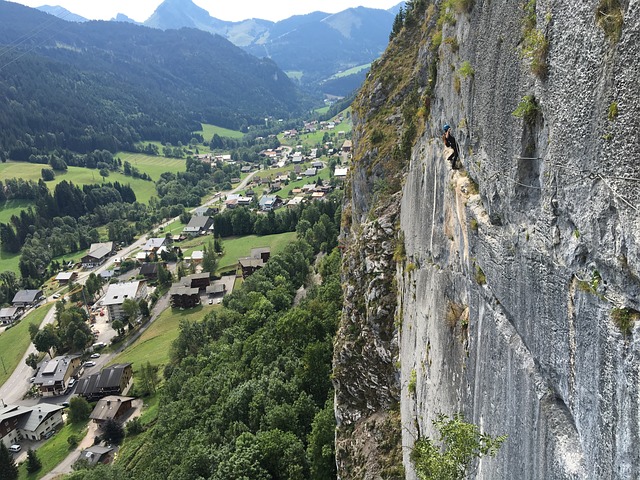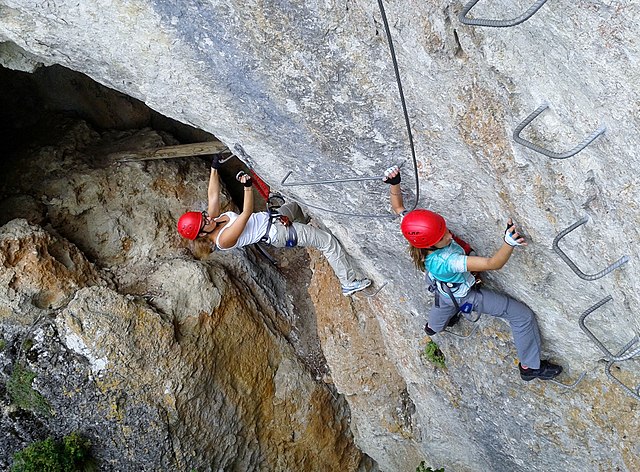When it comes to via ferrata, France has endless opportunities. There are thought to be over 200 via ferratas set up in the French mountainsides. Some of these routes are seriously tricky but others are straightforward enough for beginners to climb. This makes France the ideal country to get into via ferrata!
Here I look at a few good regions and routes to test out your rock scrambling skills. Whether you are already a pro mountaineer or want to add an adventurous element to your hiking routes in France, this might just give you a few ideas
Via Ferrata France - Know Before You Go
What Is The Best Time For Via Ferrata France?
Overall, the best time for via ferrata in France is during the European summer (June-October) when the weather is more predictable and almost all routes are open. Even within France, climbing season can vary depending on the location in the country.
In the French Alps, for example, the via ferrata season typically runs from May to October, with July and August as peak season. The weather is usually warm and dry, making it ideal for climbing.
In other parts of France, such as the Pyrenees or the Vercors, the via ferrata season can varies in length depending on the altitude and climate. Some routes may be open year-round, while others may be closed during the winter months (Nov- March) due to snow and ice.
It's important to note that the weather in the mountains can be unpredictable. Sudden storms, snow and rain can create dangerous conditions. Always check the recent weather forecast and conditions before heading out on a climb.
What Gear Do I Need For Via Ferrata In France?
When you're planning to do via ferrata, you'll need a few essential pieces of gear to ensure your safety and comfort.
Here's a list of some of the most important items:
Helmet: A helmet is essential for protecting your head from falling rocks and other debris. Make sure to choose a helmet that fits well and is designed for climbing or via ferrata.
Harness: A harness is used to attach yourself to the via ferrata cable. Via ferrata requires seat harnesses.
Via ferrata lanyard: A via ferrata lanyard is a special type of shock-absorbing safety device that connects your harness to the via ferrata cable. This device is designed to stretch and absorb the shock of a fall. It needs to be graded specifically for via ferrata use.
Shoes: Climbing shoes are first choice but other hiking shoes with good grip are also fine. Preferably nothing too bulky as you will struggle with smaller footholds. Trail running shoes can be a good choice.
Backpack: A small backpack is necessary to carry snacks, water and extra layers. Don't take anything too heavy or it will upset your balance on the cliffs.
You can rent via ferrata kit from the nearby towns and mountain huts. If you are considering buying your own gear, read this via ferrata gear review and buyers guide.
The French Difficulty Rating System For Via Ferrata
In France, the difficulty rating system for via ferrata uses a scale of six levels. This is quite different to the Swiss via ferrata system.
Here's an overview of the difficulty levels, from easiest to hardest:
- F (Facil): Easy. Suitable for beginners and families with children. Typically features wide ledges, easy-to-grip holds, and short sections of cable.
- PD (Peu Difficile): Slightly difficult Slightly more challenging but still appropriate for beginners. May include steeper sections or longer stretches of cable.
- AD (Assez Difficle): Moderately difficult. Requires some strength and technique, and may include overhanging sections, exposed traverses, or more vertical ascents. These routes are usually still fine for beginners so long as they are with an experienced climber.
- D (Difficile): Difficult. A serious challenge, with longer and steeper sections, smaller holds, and more exposure. Requires good endurance and confidence with heights.
- TD (Tres Difficile): Very difficult. Only for experienced climbers with excellent physical fitness and technical skills. May involve sustained overhanging sections, demanding strength moves, or long, exposed traverses.
- ED (Extrement Difficile): Extremely difficult. Reserved for expert climbers with extensive experience and advanced skills. Features very steep or overhanging terrain, small and distant holds, and extreme exposure.
There may also be a + or - added to the rating to specify on what end of the grading the route is.
Via Ferrata In France - Top Regions and Routes
1. Via Ferrata, Chamonix
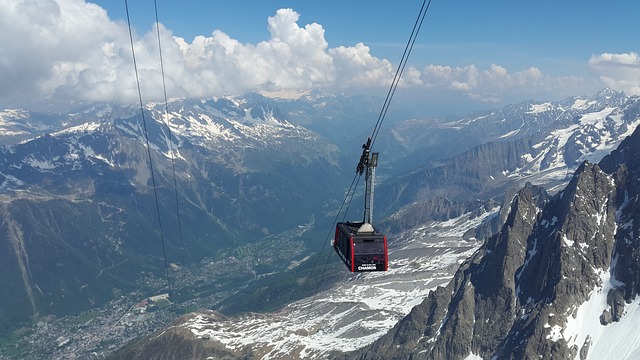
Chamonix, on the east of France, is a world-renowned destination for mountain sports There are several excellent via ferrata routes in and around Chamonix, these are some favorites:
Curalla via ferrata
The Curalla via ferrata, which is located on the south face of the Aiguille du Midi, 30 minutes outside Chamonix. The short route offers amazing views of Mont Blanc.
This route is moderate but there are drops that are high enough to be fatal. This means it's not suitable for children under 12 and beginners.
From the carpark, it is a 20 minute walk up to the via ferrata. The secured course includes wooden beams, bridges and cables. Once you are done, it is an easy 40 min back down. In total, there is an elevation gain of 180m (590ft).
- Distance: 3km (500m via ferrata)
- Estimated Time: 1.3 -2hrs
- Difficulty Rating: AD
Via Ferrata des Evettes (Beginner Friendly)
You can reach the start of this route from the La Flegere cable car. From the top of the cable car, it is a 20 minute walk to the via ferrata.
The first part is three steep rockfaces which go almost halfway. If you are tired at this point, there is an exit route. If you still have time and energy continue on for more vertical hiking and a 50m long Himalayan bridge. If you don not want to do the bridge, there is a second chance to exit.
After the bridge, you can either return to the cable car station or continue on to Section 2. Section 2 continues up the via Corda which is an easy mountaineering route with bolts.
- Distance: 2.4km (1.5 miles)
- Estimated Time: 2-3 hrs round trip (via ferrata only) OR 6hrs with Section 2
- Difficulty Rating: PD
Via Ferrata du Park Thermal
This via ferrata in Saint Gervais is said to be the most difficult in Chamonix. Th route leads along the cliffs of Gorges de Bonnant. You need to be experienced in via ferrata climbing and in good physical condition to take this on.
The first part is moderate but soon you are climbing along completely exposed rock face with a very long drop down. The footholds are quiet small and tricky to navigate. The second and third sections are rated as intermediate to very difficult.
In addition to the cable ways and climbing sections, there isa monkey bridge and suspension bridges (Nepalese walkways).
- Length: 600m (0.4 miles)
- Estimated Time: 3.5 hrs (all three sections)
- Difficulty Rating: TD
2. Les Eschelles de la Mort - Charquemont
‘Les Éschelles de la Mort’ translates to "the ladders of death. "But don’t worry, its not as bad as it sounds! Located in the Doubs valley on the border of France and Switzerland, the ladders here were originally made of wood and used by smugglers.
The steep rock walls, with some overhanging sections require good arm strength and previous climbing experience.
The route was set up in 2008 and allows visitors to navigate 500m up limestone cliff. You will pass by the Aiguille de la Mort, a large freestanding rock pillar.
Les Echelles via ferrata has a few. Suspension bridges, beams and ladders. a highlight is an optional short zipline at the end. You will need to have a pulley system (Tyrolienne) if you want to do this without a guide.
There are 3 exits along the way so you can choose to only do a section or two.
- Length: 500m (0.4 miles)
- Estimated Time: 2 hrs
- Difficulty Rating: D
3. Du Roc du Vent Via Ferrata - Savoi (Beginner Friendly)
A perfect introductory route just outside La Chapelle-du-Mont-du-Chat, Savoie. This route gives a spectacular view of the Roseland and Gittag Lakes with Mont Blanc in the background.
You can get to this via ferrata from Buefort village or Tarentaise. Park at the Plaan de Lai Refuge, before Cormet de Roseland. From here it is a 40-minute walk to the start of the coarse
This via ferrata has different sections with escape options in-between. It is suitable for most levels of experience and also families with children.
The first part is a fairly uncomplicated climb with rock footholds. The rock is smooth from thousands of hands and feet, it can be slippery and you will need to hold the cable in some places. Gloves will be useful here!
After reaching the top of Rocher du Vent (2326m), there are more surprises on the way down. You will need to cross a cable bridge and there are more sections of secured cables. Finally, you will reach the tunnel, which is about 100m long. it’s helpful to have a headlamp for this last bit.
- Length: 6km (3.7 miles) (±800m via ferrata)
- Estimated Time: 4-5 hrs
- Difficulty Rating: AD
4. Morzine Via Ferratas
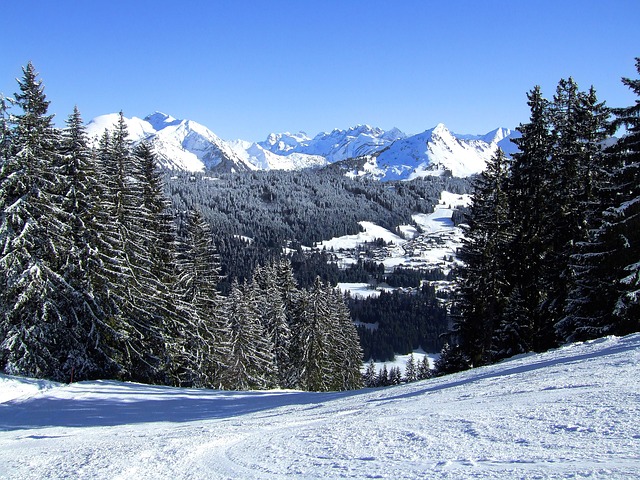
Morzine, France
There are several via ferrata sites around the Morzine ski resort in the French Alps. This makes Morzine a popular base for mountaineers and adventure seekers.
The Morzine ferratas are technically open year-round but authorities often close them mid-winter (November- March).
Tête de l’Eléphant Via Ferrata (Beginner Friendly)
15 minutes drive from Morzine. This trail has two main sections, a red and a black route. The easier trail is known as Tête de l’Eléphant (Elephant’s head). At the top there are amazing views of Roc d’Enfer, St Jean d’Aulps and Mont Blanc.
The Elephant’s Head via ferrata is rated ‘difficult’ due to exposure. It is suitable for most mountaineers, including beginners with a guide or experienced partner
The second trail, Voie de l’Oeil, (Path of the Eye) is rated as extremely difficult. Many people consider this one of the most challenging via ferratas in France, you should only attempt this if you have experience.
The trail takes you up successive passages and overhangs. It is an athletic route to the summit that requires excellent fitness There are several exits along this course where you can rejoin the Elephant’s Head trail.
- Length: 2.5km (1.6 miles)
- Estimated Time: 45min - 1hr 30 min
- Difficulty Rating: D -ED
Via Ferrata La Saix Du Tour, Avoriaz ( Beginner Friendly)
Avoriaz is about 10 minutes drive from Morzine. The approach to this via ferrata is only a ten minute walk and then you attach to cables. On this route you will climb almost straight up the rockface using metal rungs and bridge crossings.
It is a good route for beginners. Depending on your confidence levels, you can opt for the more challenging detours
All the way up this course you have birds eye view of the town below as well as the valley.
- Length: 3.2km (2 miles)
- Estimated Time: 2hrs
- Difficulty Rating: AD -D
5. La Rocher de Saint Julien - Buis les Baronnies
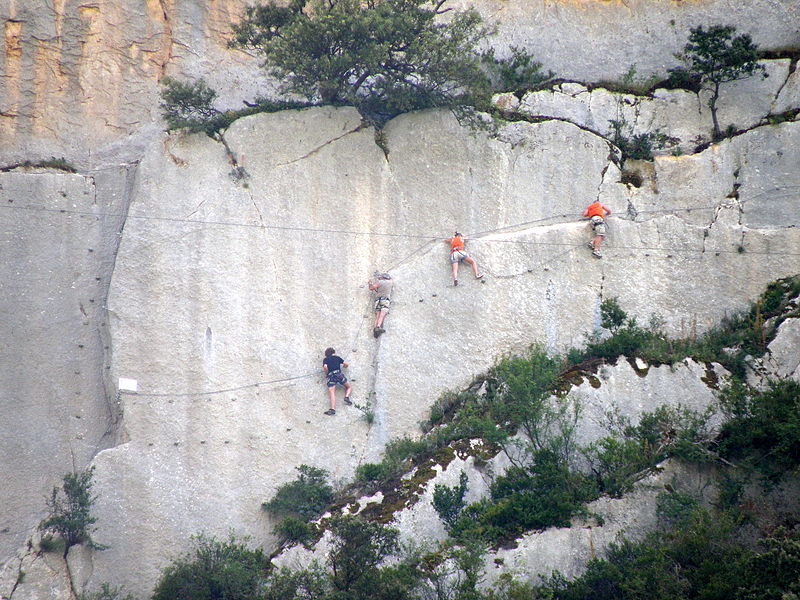
La Rocher de Sainte Julien (Phot credit: Torsade de Pointes)
This route in Buis les Baronnies is made up of 4 via ferratas that are suitable for all experience levels. They are color coded as green (easy), blue, red and black trails.
In total, there is 1700m of via ferrata which, if you have the skills and fitness, can be combined into a single outing. What's nice about these trails is that they positioned on the North face. This means the cables are in shade on summer afternoons.
Green Route - La Pitchauno / The Little One (Beginner Friendly)
Suitable for beginners as an initiation via as well as for families with young children. This course is very short and has a monkey bridge, climbing net, a Nepalese bridge and a beam crossing.
- Length: 170m (0.4 miles)
- Estimated Time: 0.5-1hr
- Difficulty Rating: F
Blue Route -La Testouriasso /The Stubborn One (Beginner Friendly)
Children should be 1.5m tall to access this course. There are some sections with a slight overhang on this route. As the name suggests, this is more of a challenge than the green route. There you can expect to encounter steeper rock sections, a wall beam and a monkey bridge.
- Length: 460m (0.3 miles)
- Estimated Time: 1.5 - 2hr
- Difficulty Rating: D
Red Route - Thiousso / The Tough One
This is a challenging route that requires some experience in mountaineering. Along with bridges, there's also an optional zip-line. This via ferrata requires good fitness to reach the top. Its worth it for the 360 panoramic view.
- Length: 460m (0.3 miles)
- Estimated Time: 2- 2.5hr
- Difficulty Rating: TD
Black Route -La Casse-Cul
This is the hardest of the four routes and is only for experienced mountaineers. Even for good climbers, the course is a challenge taking adventurers over Nepali bridges, monkey bridges, beams and more technical, vertical climbing sections. Footholds are smaller and further apart.
- Length: 640m (0.4 miles)
- Estimated Time: 3hrs
- Difficulty Rating: TD

